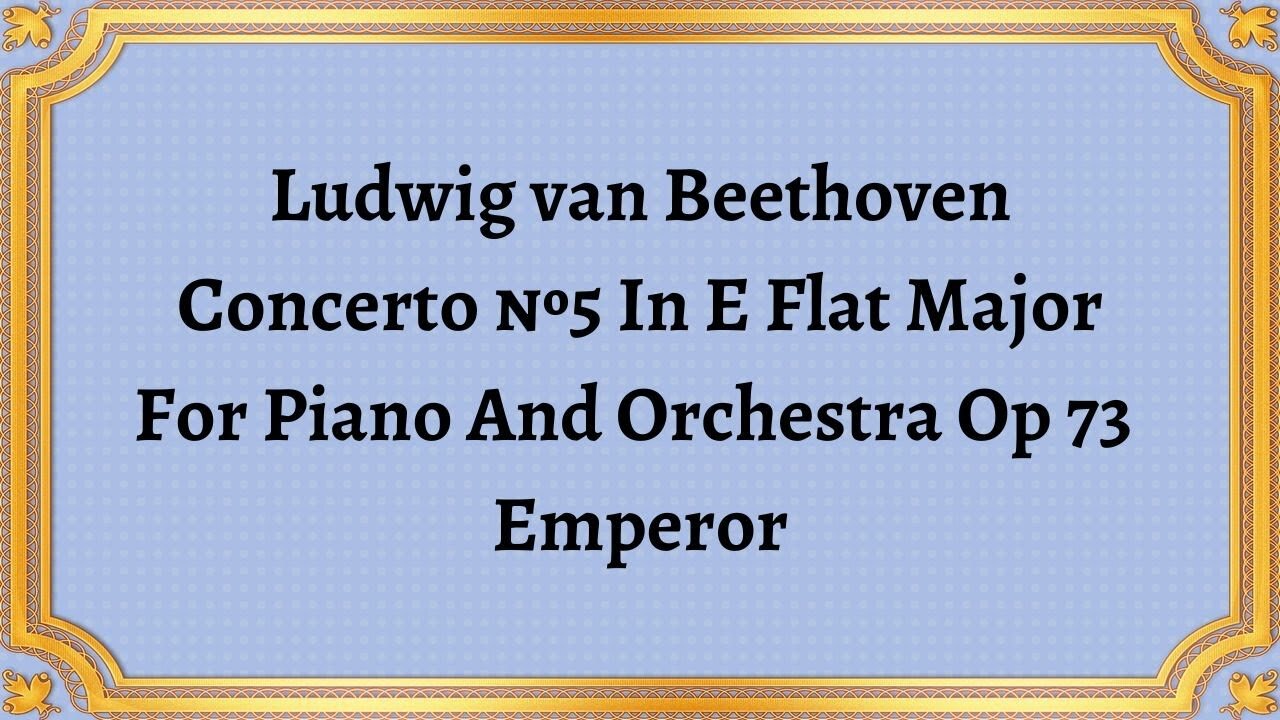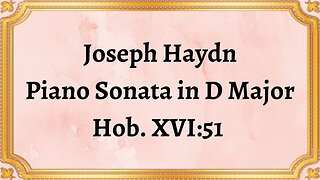Premium Only Content

Ludwig van Beethoven Concerto №5 In E Flat Major For Piano And Orchestra Op 73 Emperor
#Beethoven #ClassicalMusic #ConcertoNo5 #Piano #Orchestra #EFlatMajor #Op73 #Emperor #MusicalComposition #LudwigVanBeethoven #Symphony
Publication date 1951
Walter Gieseking, Piano, with Herbert von Karajan conducting The Philharmonia Orchestra
Ludwig van Beethoven, an iconic figure in the history of classical music, composed numerous groundbreaking works that continue to inspire and captivate audiences. Among his remarkable compositions, Concerto No. 4 in G Major for Piano and Orchestra, Op 58, holds a special place.
Ludwig van Beethoven composed Concerto No. 4 in G Major between 1805 and 1806, during a pivotal period in his career. This concerto was written during the transition from his early Classical style to the groundbreaking and emotionally charged compositions of his middle period. It premiered in 1808 in Vienna and showcased Beethoven's virtuosity as a pianist and his innovative approach to orchestration.
Beethoven's Concerto No. 4 follows the traditional three-movement structure of a concerto:
a. Movement I - Allegro moderato: The concerto opens with a majestic orchestral introduction, followed by the piano's grand entrance. The movement unfolds with a dialogue between the piano and the orchestra, showcasing Beethoven's mastery of thematic development.
b. Movement II - Andante con moto: The second movement transitions to a lyrical and introspective theme, offering a moment of serene beauty and emotional depth.
c. Movement III - Rondo: Vivace: The concerto concludes with a lively and energetic rondo, featuring dazzling piano passages and a spirited interplay between the soloist and the orchestra.
Beethoven's Concerto No. 4 is scored for a full orchestra, including strings, woodwinds, brass, and percussion. The piano takes on a prominent role, engaging in a dynamic dialogue with the orchestra throughout the piece.
Beethoven's melodic lines in Concerto No. 4 are characterized by their expressiveness and richness. The harmonies are bold and adventurous, showcasing Beethoven's exploration of new tonal possibilities and pushing the boundaries of traditional classical music.
Beethoven's Concerto No. 4 represents a significant evolution in the piano concerto genre. Its introspective and poetic qualities, combined with Beethoven's innovative orchestration, paved the way for future composers to explore the expressive potential of the piano and its relationship with the orchestra.
Concerto No. 4 is renowned for its emotional depth and introspective character. Beethoven's ability to convey a wide range of emotions through his intricate melodies and harmonies resonates with audiences even today, making it a beloved staple of the classical repertoire.
The piano part in Concerto No. 4 demands exceptional technical skill and musicality from the soloist. It presents a formidable challenge, requiring the performer to navigate complex passages, display dynamic control, and convey the emotional depth inherent in Beethoven's composition.
Conclusion:
Ludwig van Beethoven's Concerto No. 4 in G Major for Piano and Orchestra, Op 58, stands as a testament to the composer's genius and his immense contribution to classical music. Its historical context, distinctive musical elements, and enduring significance make it a true masterpiece. Beethoven's innovative approach to the piano concerto genre, his emotional depth, and technical demands have solidified Concerto No. 4 as an essential work in the classical repertoire, inspiring generations of musicians and enchanting audiences with its beauty and power.
You have the opportunity to support the channel https://destream.net/live/RadSiarAl/donate
-
 6:07
6:07
Classical music_Music Inspiration
1 month agoJoseph Haydn Piano Sonata in D Major, Hob. XVI:51
861 -
 1:46:14
1:46:14
Kim Iversen
9 hours agoTrump to Zelenskyy: 'You're Gambling with World War III'
86.3K131 -
 55:28
55:28
Glenn Greenwald
11 hours agoGlenn Reacts to Trump-Zelensky Exchange and Takes Q&A from our Members | SYSTEM UPDATE #415
134K231 -
 4:26:54
4:26:54
Nerdrotic
13 hours ago $38.63 earnedMarvel PANIC MODE! Kathleen Kennedy GONE?! Hollywood DEI Dead | Friday Night Tights 342 Nick Freitas
145K39 -
 1:30:03
1:30:03
Flyover Conservatives
1 day agoZelensky Fail... God Called IT!; From Prison to the White House: Angela Stanton King’s Unbelievable Redemption Story | FOC Show
58.7K6 -
 1:06:14
1:06:14
IsaacButterfield
13 hours ago $2.39 earnedFree Speech Is Dead | Did Trump Go Too Far? | Sexist Job
49.7K21 -
 1:02:59
1:02:59
Sarah Westall
15 hours agoEpstein Files, Dueling Cabal Factions and Gold from Ancient Civilizations w/ Dave Hodges
77.9K23 -
 3:15:08
3:15:08
I_Came_With_Fire_Podcast
13 hours ago“Trump-Zelensky BEATDOWN | Europe BUILDS MUSCLE | NEWSCUM Podcast”
22.3K2 -
 41:25
41:25
CatfishedOnline
14 hours ago $2.21 earned23-Yr-Old Drove 2,650 Miles to Meet Online Girlfriend in Romance Scam
44K6 -
 1:56:18
1:56:18
Bare Knuckle Fighting Championship
2 days agoCountdown to BKFC FIGHT NIGHT ALBUQUERQUE & FREE LIVE FIGHTS!
38.4K2